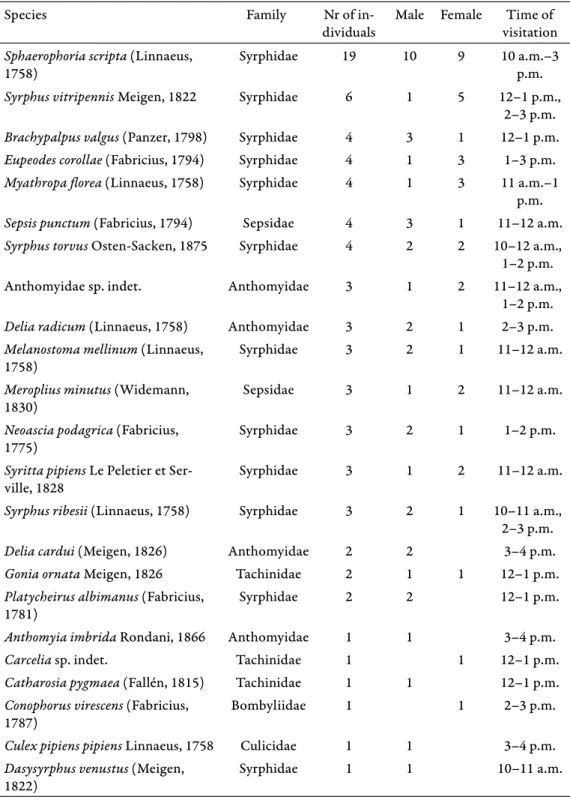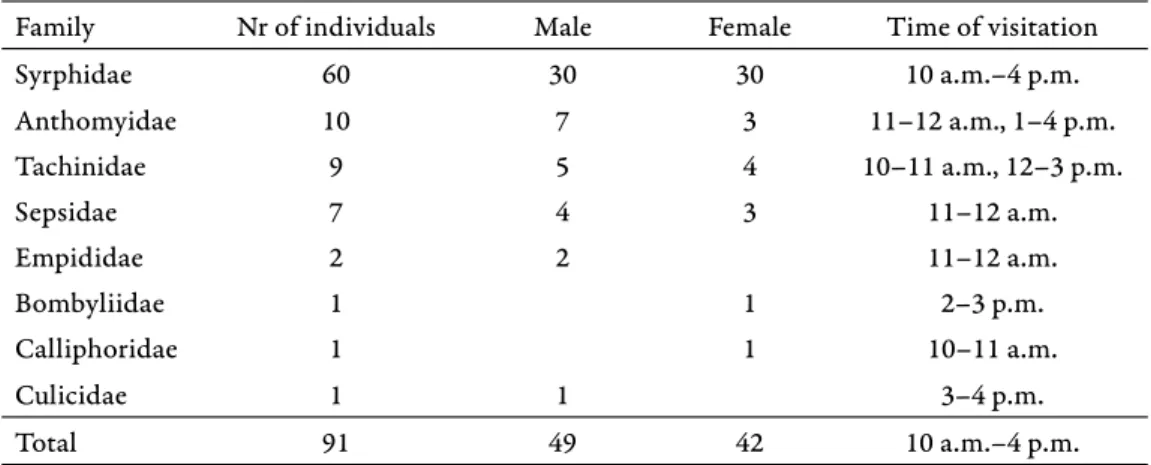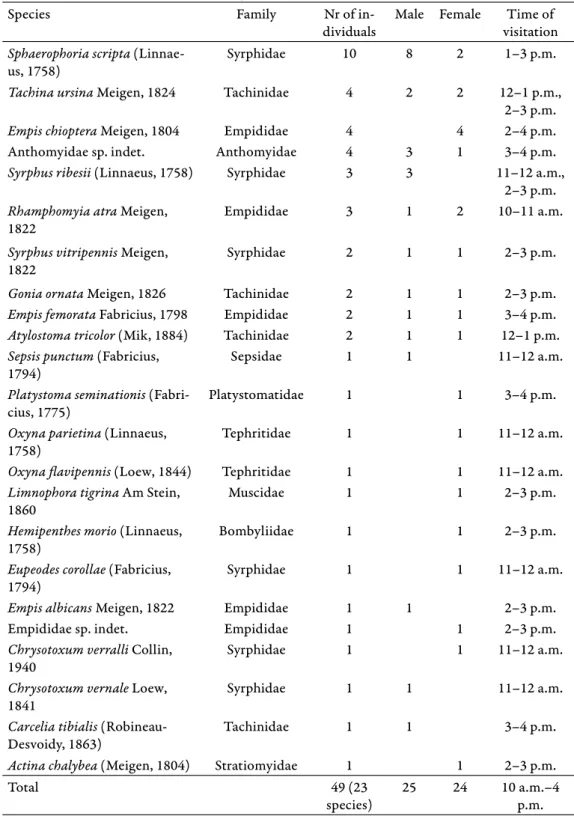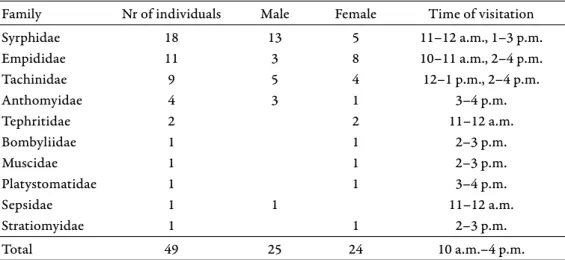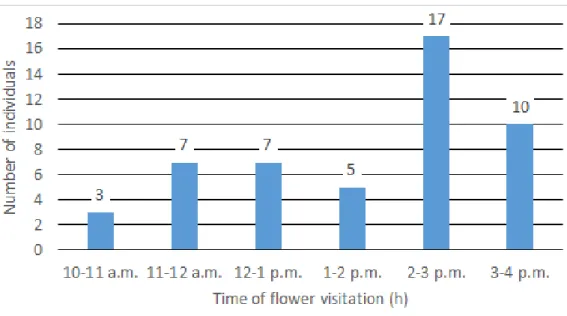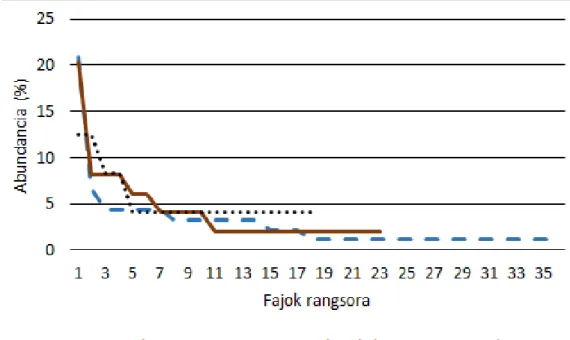DIPTERA FLOWER VISITORS OF ADONIS VERNALIS IN THE BAKONY MTS (HUNGARY)
Tünde Mészáros1* and Sándor Tóth2
1Department of Plant Sciences and Biotechnology, Georgikon Faculty, University of Pannonia H–8360 Keszthely, Festetics u. 7, Hungary; *meszarost773@gmail.com
2H–8420 Zirc, Széchenyi u. 2, Hungary
Mészáros, T. & Tóth, S. (2020): Diptera fl ower visitors of Adonis vernalis in the Bakony Mts (Hungary). – Studia bot. hung. 51(1): 41–56.
Abstract: Th e number of pollinators has decreased signifi cantly in the last decades, producing a situation that is frequently mentioned as a “pollination crisis”. In our study we document Diptera taxa collected on the early-fl owering, legally protected Adonis vernalis L. According to our former observations, species of the Aculeata suborder (Hymenoptera) are the main pollinators of A. ver- nalis. Besides them many insects visit the fl owers of Adonis, thus helping pollination directly or indirectly. Diptera taxa were collected in the spring of 2019 from three sites of the Bakonyvidék Meso region in Hungary. At Szentkirályszabadja and Veszprém-Kádárta villages the species Sphae- ro phoria scripta (19 and 10 individuals, respectively), on the Csatár Hill Chrysotoxum vernale and Pipi zella viduata (3–3 individuals) were found the most frequent visitors. At each study site most of the collected insects were members of the Syrphidae family. Of the collected Diptera species only 2 species belonged to the Nematocera suborder, all the others belonged to the Brachycera suborder.
At Veszprém-Kádárta we also found three Tephritidae larvae in the fl owers.
Key words: fl ower-visiting insects, fl y, protected plant species, Sphaerophoria, Syrphidae
INTRODUCTION
Th e number of pollinators has decreased signifi cantly in the last decades, producing a situation that is frequently mentioned as a “pollination crisis”. Th e crisis is partly due to the spread of agriculture at the expense of natural and semi- natural grasslands, which considerably decreases the food resources of fl ower visitor and pollinator insects. Th is phenomenon is not only economically worry- ing, but has unfavourable eff ects on biodiversity and nature conservation as well (Allen-Wardell et al. 1998, Novais et al. 2016).
Diptera taxa have a signifi cant role in many pollination systems and net- works (Kearns 2002, Kevan 2002, Ssymank et al. 2008). Th ey get protein from pollen, while fl owers provide them shelter and can function as place of meeting or breeding (Patkó 2017). Sun facing fl owers provide a shelter that is warmer than the surrounding air temperature. Compared to Hymenoptera species, Diptera taxa have less hair on their body, and generally they do not have special pollen
collecting structures. Nevertheless, pollen can stick to their body, so they poten- tially can help pollination (Kearns 2002, Kevan 2002, Ssymank et al. 2008).
Th e number of Diptera species is estimated at 400,000–800,000. In spite of this large number, the order is poorly studied taxonomically. 115 Diptera fami- lies occur in Hungary, and among them hoverfl ies are most thoroughly studied (Soltész 2017). Most Diptera species are restricted to habitats that provide op- timal circumstances for them. Th e species composition of Diptera fauna in for- ests and grasslands is very diff erent (Tóth 1975).
Empididae species have strong proboscis. Th ey are generally predatory fl ies hunting mainly for other fl y species (cannibalism is frequent). Nonetheless, some of them are fl ower visitors feeding on nectar (Tóth 1975).
Stratiomyidae adults can oft en be collected on fl owers as they feed on nectar and pollen. Th eir larvae usually evolve in water, and the adults also prefer humid habitats like marshes (Tóth 1975).
Th e larvae of Tephritidae live in diff erent plant organs. Most of them evolve in Asteraceae species (Tóth 1975).
Bombyliidae species are generally medium sized and oft en hairy. Th ey feed on nectar. Some species hover in the air over the fl owers and use their long, straight proboscis to reach the nectar. Other species land on fl owers to feed (Tóth 1975).
Hoverfl ies play important role in food chains, since both their adults and lar- vae are food resources to predatory insects and other arthropods, birds, and ver- tebrates (Tóth 2011). Adult hoverfl ies (Syrphidae) feed on nectar (Tóth 1975), but they eat honeydew and sap leaking from wounded trees as well. Hoverfl ies feeding on pollen and/or nectar (similarly to bees and other fl ower visiting in- sects) can take part in pollination as they fl y from fl ower to fl ower. However, the larvae of some hoverfl ies (e.g. Eumerus, Merodon) damage the bulb of plants.
According to our earlier observations species of the Aculeata suborder (Hymenoptera) are the main pollinators of A. vernalis (Mészáros and Józan 2018). Besides them many insects are visiting the fl owers of Adonis, thus helping pollination directly or indirectly.
Pollinators play a key role in the maintenance of genetic variability of A.
vernalis, and in the survival of its populations (Denisow et al. 2014). Th e fl owers of A. vernalis are nectarless, and thus provide only pollen as a reward for fl ower visitor insects (Denisow et al. 2014). Th e results of Chittka et al. (1999) show that nectarless species have fewer visitors than those producing nectars, even if they fl ower at the same time. Nectarless species develop other strategies to attract insects. Denisow and Wrzesień (2006) observed Diptera taxa on A. vernalis fl owers, but they did not present the name of species.
Entomologists oft en curious about which plants are visited regularly or occa- sionally by diff erent hoverfl y species. Similar studies have been done in Hungary too, mainly in the Bakony Mts. Th e results were published in the monograph of the hoverfl y fauna of the Bakony Mts (Tóth 2001). Foraging of adult hoverfl ies had been observed on 446 plant taxa. Plants visited by hoverfl ies are very various.
According to the above-mentioned studies in the Bakony Mts, the most plant species were visited by Eristalis tenax (Linnaeus, 1758) (observed on 242 plant taxa), Eristalis arbustorum (Linnaeus, 1758) (237 plant taxa), and Sphaerophoria scripta (Linnaeus, 1758) (218 plant taxa).
Previous studies in the Bakony Mts have detected the following hoverfl ies on the fl owers of Adonis aestivalis (which is a close relative of A. vernalis): Cheilosia pagana (Meigen, 1822), Episyrphus balteatus (De Geer, 1776), Eristalinus aene- us (Scopoli, 1763), Eristalis arbustorum (Linnaeus, 1758), E. tenax (Linnaeus, 1758), Eupeodes corollae (Fabricius, 1794), Helophilus pendulus (Linnaeus, 1758), Melanostoma mellinum (Linnaeus, 1758), Platycheirus clypeatus (Meigen, 1822), P. europaeus Goeldlin de Tiefenau, Maibach et Speight, 1990, Scaeva pyrast- ri (Linnaeus, 1758), Sphaerophoria scripta (Linnaeus, 1758). On the fl owers of A. vernalis the following species have been identifi ed: Cheilosia grossa (Fallén, 1817), C. mutabilis (Fallén, 1817), C. pagana (Meigen, 1822), Eristalinus aeneus (Scopoli, 1763), E. sepulchralis (Linnaeus, 1758), Eristalis arbustorum (Linnaeus, 1758), E. pertinax (Scopoli, 1763), E. tenax (Linnaeus, 1758), Eupeodes corollae (Fabricius, 1794), Melanostoma mellinum (Linnaeus, 1758), M. scalare (Fabricius, 1794), Platycheirus albimanus (Fabricius, 1781), P. clypeatus (Meigen, 1822), P.
europaeus Goeldlin de Tiefenau, Maibach et Speight, 1990, Sphaerophoria scripta (Linnaeus, 1758), Syrphus ribesii (Linnaeus, 1758), S. torvus Osten-Sacken, 1875, S. vitripennis Meigen, 1822.
In our study we document Diptera taxa collected on the early-fl owering, le- gally protected Adonis vernalis L.
MATERIALS AND METHODS Study species
Adonis vernalis is a perennial, early-fl owering member of the Ranunculaceae family. Its fl owers are solitary and bisexual. Th e yellow, silky shining petals open to sunlight and have no nectaries (Anonymous 2000, Denisow et al. 2014, Jankowska-Błaszczuk 1988). In suitable weather the fi rst buds open at the end of March, and the fl owering can last until May. Th e longitudinal growth of primary shoots is simultaneous with the opening of the fi rst fl owers, and the ap- pearance and growth of secondary shoots start at the same time. Th e fl owers of
primary shoots open fi rst at all times, the buds on secondary shoots open later.
As a consequence, buds, fl owers, and fruits can be seen simultaneously on the same individual (Máthé 1977).
Collecting Diptera
Diptera individuals were collected in the spring of 2019 from three sites of the Bakonyvidék Mesoregion in Hungary (Dövényi 2010) (Table 1). At Szentkirályszabadja and Veszprém-Kádárta villages the insects were collected in a 23-hour long period, while on the Csatár Hill the total length of collecting was 22 hours.
Only insects found on A. vernalis fl owers were collected. Th e sites were scanned by 1–3 researchers continuously. Insects were collected with a butterfl y net 30 cm in diameter, but the original net had been replaced by a dense and transparent tulle net.
Insects have been collected individually and put into glasses every hour. As a consequence, each individual has been counted once, representing a single fl ower visitation. For the sake of effi ciency, the fl ies were not sorted according to their behaviour (e.g. feeding, sleeping, breeding in the fl ower). If larvae were found, they were put in glasses immediately.
Th e time of observation has been converted from standard time to summer time to make the comparison of data from diff erent periods possible. Th e col- lected species have been identifi ed by Sándor Tóth according to Majer (1977), Mihályi (1960, 1975, 1979), Tóth (1977) and Wéber (1975).
RESULTS
At Szentkirályszabadja village we collected 91 individuals representing 36 species (8 families). 53.8% of individuals were male (49 individuals) and 46.2%
Table 1. Adonis vernalis study sites.
Settlement N E Nr of in-
dividuals
Habitat type
Study area (m2)
Collecting days (2019) Szentkirály-
szabadja
47.035700 17.950291 ca 1,000 slope steppe
2,000 30, 31 March, 4, 6, 19 April Csatár Hill 47.101894 17.853644 20,000–
30,000
slope steppe
1,200 19, 30 March, 20, 21, 30 April,
1, 2, 3 May Veszprém-
Kádárta
47.108191 17.956996 ca 100 slope steppe
900 15, 17, 22, 24, 25, 27, 28 April
female (42 individuals) (Tables 2–3). Th e lowest number of individuals were col- lected between 10–11 a.m. and 3–4 p.m. (6 individuals per hour), whereas most specimens were observed between 11 a.m.–1 p.m. and 2–3 p.m. (22 individuals per hour) (Fig. 1). At Veszprém-Kádárta village 49 individuals of 23 species (10 families) were collected. Th e ratio of males was 51% (25 individuals) and that of females 49% (24 individuals) (Tables 4–5). Th e frequency of visitations was the lowest between 10–11 a.m. (3 individuals per hour) and the highest between 2–3 p.m. (17 individuals per hour) (Fig. 2). On the Csatár Hill we collected 24 individuals of 18 species (6 families). 29.2% of them was male (7 individuals) and 70.8% was female (17 individuals) (Tables 6–7). Th e lowest number of indi- viduals were collected between 2–4 p.m. (0 individuals per hour), whereas most specimens were observed between 11–12 a.m. (12 individuals per hour) (Fig. 3).
In sum, at the three sites the number of collected individuals was the lowest be- tween 10–11 a.m. (14 individuals per hour), while the highest between 11–12 a.m. (41 individuals per hour) (Fig. 4).
At Szentkirályszabadja and Veszprém-Kádárta villages Sphaerophoria scripta (Linnaeus, 1758) was found the most frequent species (19 and 10 indi- viduals), while on the Csatár Hill the species Chrysotoxum vernale Loew, 1841 and Pipizella viduata (Linnaeus, 1758) dominated with 3–3 individuals. At each site most of the collected insects were members of the Syrphidae family, only 2 belonged to the Nematocera suborder. All the others belonged to the Brachycera suborder. At Veszprém-Kádárta we also found three Tephritidae lar- vae in the fl owers.
DISCUSSION
All Syrphidae species collected in our study had already been reported from the Bakony Mts, but not each of them had been observed on Adonis vernalis fl ow- ers. Tóth (2001) recognised 7 hoverfl y species (Eupeodes corollae, Melanostoma mellinum, Platycheirus albimanus, Sphaerophoria scripta, Syrphus ribesii, S. torvus, S. vitripennis) on A. vernalis. We have recorded 24 Syrphidae species, so the list of hoverfl ies visiting A. vernalis increased by 17 new species. In contrast to former observations in the Bakony Mts, we have not noticed individuals of the follow- ing species on A. vernalis fl owers: Cheilosia grossa (Fallén, 1817), C. mutabilis (Fallén, 1817), C. pagana (Meigen, 1822), Eristalinus aeneus (Scopoli, 1763), E.
sepulchralis (Linnaeus, 1758), Eristalis arbustorum (Linnaeus, 1758), E. pertinax (Scopoli, 1763), E. tenax (Linnaeus, 1758), Melanostoma scalare (Fabricius, 1794), Platycheirus clypeatus (Meigen, 1822) and P. europaeus Goeldlin de Tiefenau, Maibach et Speight, 1990.
Table 2. Adonis vernalis fl ower visitor Diptera species listed in decreasing frequency (Szent király szabadja, 2019).
Species Family Nr of in-
dividuals
Male Female Time of visitation Sphaerophoria scripta (Linnaeus,
1758)
Syrphidae 19 10 9 10 a.m.–3
p.m.
Syrphus vitripennis Meigen, 1822 Syrphidae 6 1 5 12–1 p.m.,
2–3 p.m.
Brachypalpus valgus (Panzer, 1798) Syrphidae 4 3 1 12–1 p.m.
Eupeodes corollae (Fabricius, 1794) Syrphidae 4 1 3 1–3 p.m.
Myathropa fl orea (Linnaeus, 1758) Syrphidae 4 1 3 11 a.m.–1 p.m.
Sepsis punctum (Fabricius, 1794) Sepsidae 4 3 1 11–12 a.m.
Syrphus torvus Osten-Sacken, 1875 Syrphidae 4 2 2 10–12 a.m., 1–2 p.m.
Anthomyidae sp. indet. Anthomyidae 3 1 2 11–12 a.m.,
1–2 p.m.
Delia radicum (Linnaeus, 1758) Anthomyidae 3 2 1 2–3 p.m.
Melanostoma mellinum (Linnaeus, 1758)
Syrphidae 3 2 1 11–12 a.m.
Meroplius minutus (Widemann, 1830)
Sepsidae 3 1 2 11–12 a.m.
Neoascia podagrica (Fabricius, 1775)
Syrphidae 3 2 1 1–2 p.m.
Syritta pipiens Le Peletier et Ser- ville, 1828
Syrphidae 3 1 2 11–12 a.m.
Syrphus ribesii (Linnaeus, 1758) Syrphidae 3 2 1 10–11 a.m.,
2–3 p.m.
Delia cardui (Meigen, 1826) Anthomyidae 2 2 3–4 p.m.
Gonia ornata Meigen, 1826 Tachinidae 2 1 1 12–1 p.m.
Platycheirus albimanus (Fabricius, 1781)
Syrphidae 2 2 12–1 p.m.
Anthomyia imbrida Rondani, 1866 Anthomyidae 1 1 3–4 p.m.
Carcelia sp. indet. Tachinidae 1 1 12–1 p.m.
Catharosia pygmaea (Fallén, 1815) Tachinidae 1 1 12–1 p.m.
Conophorus virescens (Fabricius, 1787)
Bombyliidae 1 1 2–3 p.m.
Culex pipiens pipiens Linnaeus, 1758 Culicidae 1 1 3–4 p.m.
Dasysyrphus venustus (Meigen, 1822)
Syrphidae 1 1 10–11 a.m.
Table 2. (continued)
Species Family Nr of in-
dividuals
Male Female Time of visitation
Empis opaca Meigen, 1904 Empididae 1 1 11–12 a.m.
Epistrophe eligans (Harris, 1780) Syrphidae 1 1 3–4 p.m.
Epistrophe melanostoma (Zetter- stedt, 1843)
Syrphidae 1 1 3–4 p.m.
Exorista larvarum (Linnaeus, 1758) Tachinidae 1 1 2–3 p.m.
Gonia divisa Meigen, 1826 Tachinidae 1 1 1–2 p.m.
Hebia fl avipes Robineau-Desvoidy, 1830
Tachinidae 1 1 1–2 p.m.
Leucophora personata (Collin, 1922) Anthomyidae 1 1 1–2 p.m.
Meliscaeva cinctella (Zetterstedt, 1843)
Syrphidae 1 1 2–3 p.m.
Pollenia sp. indet. Calliphoridae 1 1 10–11 a.m.
Rhamphomyia crassicornis Fallén, 1816)
Empididae 1 1 11–12 a.m.
Sphaerophoria taeniata (Meigen, 1822)
Syrphidae 1 1 2–3 p.m.
Tachina fera (Linnaeus, 1761) Tachinidae 1 1 2–3 p.m.
Tachina lurida (Fabricius, 1781) Tachinidae 1 1 10–11 a.m.
Total 91 (36
species)
49 42 10 a.m.–4
p.m.
Table 3. Adonis vernalis fl ower visitor Diptera families listed in decreasing frequency (Szentkirály szabadja, 2019).
Family Nr of individuals Male Female Time of visitation
Syrphidae 60 30 30 10 a.m.–4 p.m.
Anthomyidae 10 7 3 11–12 a.m., 1–4 p.m.
Tachinidae 9 5 4 10–11 a.m., 12–3 p.m.
Sepsidae 7 4 3 11–12 a.m.
Empididae 2 2 11–12 a.m.
Bombyliidae 1 1 2–3 p.m.
Calliphoridae 1 1 10–11 a.m.
Culicidae 1 1 3–4 p.m.
Total 91 49 42 10 a.m.–4 p.m.
Table 4. Adonis vernalis fl ower visitor Diptera species listed in decreasing frequency (Veszprém-Kádárta, 2019).
Species Family Nr of in-
dividuals
Male Female Time of visitation Sphaerophoria scripta (Lin nae-
us, 1758)
Syrphidae 10 8 2 1–3 p.m.
Tachina ursina Meigen, 1824 Tachinidae 4 2 2 12–1 p.m.,
2–3 p.m.
Empis chioptera Meigen, 1804 Empididae 4 4 2–4 p.m.
Anthomyidae sp. indet. Anthomyidae 4 3 1 3–4 p.m.
Syrphus ribesii (Linnaeus, 1758) Syrphidae 3 3 11–12 a.m.,
2–3 p.m.
Rhamphomyia atra Meigen, 1822
Empididae 3 1 2 10–11 a.m.
Syrphus vitripennis Meigen, 1822
Syrphidae 2 1 1 2–3 p.m.
Gonia ornata Meigen, 1826 Tachinidae 2 1 1 2–3 p.m.
Empis femorata Fabricius, 1798 Empididae 2 1 1 3–4 p.m.
Atylostoma tricolor (Mik, 1884) Tachinidae 2 1 1 12–1 p.m.
Sepsis punctum (Fabricius, 1794)
Sepsidae 1 1 11–12 a.m.
Platystoma seminationis (Fabri- cius, 1775)
Platystomatidae 1 1 3–4 p.m.
Oxyna parietina (Linnaeus, 1758)
Tephritidae 1 1 11–12 a.m.
Oxyna fl avipennis (Loew, 1844) Tephritidae 1 1 11–12 a.m.
Limnophora tigrina Am Stein, 1860
Muscidae 1 1 2–3 p.m.
Hemipenthes morio (Linnaeus, 1758)
Bombyliidae 1 1 2–3 p.m.
Eupeodes corollae (Fabricius, 1794)
Syrphidae 1 1 11–12 a.m.
Empis albicans Meigen, 1822 Empididae 1 1 2–3 p.m.
Empididae sp. indet. Empididae 1 1 2–3 p.m.
Chrysotoxum verralli Collin, 1940
Syrphidae 1 1 11–12 a.m.
Chrysotoxum vernale Loew, 1841
Syrphidae 1 1 11–12 a.m.
Carcelia tibialis (Robineau- Des voidy, 1863)
Tachinidae 1 1 3–4 p.m.
Actina chalybea (Meigen, 1804) Stratiomyidae 1 1 2–3 p.m.
Total 49 (23
species)
25 24 10 a.m.–4
p.m.
Although the total length of collecting was similar at each site (23, 23 and 22 hours), the number of both individuals and species diff ered signifi cantly. Th e study site at Szentkirályszabadja village appeared to be the most species rich, and the highest number of individuals was recorded here (91 individuals of 36 spe- cies). It may be the consequence of the fact that this area is bordered by forests
Table 5. Adonis vernalis fl ower visitor Diptera families listed in decreasing frequency (Veszprém-Kádárta, 2019).
Family Nr of individuals Male Female Time of visitation
Syrphidae 18 13 5 11–12 a.m., 1–3 p.m.
Empididae 11 3 8 10–11 a.m., 2–4 p.m.
Tachinidae 9 5 4 12–1 p.m., 2–4 p.m.
Anthomyidae 4 3 1 3–4 p.m.
Tephritidae 2 2 11–12 a.m.
Bombyliidae 1 1 2–3 p.m.
Muscidae 1 1 2–3 p.m.
Platystomatidae 1 1 3–4 p.m.
Sepsidae 1 1 11–12 a.m.
Stratiomyidae 1 1 2–3 p.m.
Total 49 25 24 10 a.m.–4 p.m.
* = 3 larvae were found as well
Fig. 1. Temporal distribution of Adonis vernalis fl ower visitor Diptera taxa at Szentkirályszabadja (2019).
Fig. 2. Temporal distribution of Adonis vernalis fl ower visitor Diptera taxa at Veszprém-Kádárta (2019).
Fig. 3. Temporal distribution of Adonis vernalis fl ower visitor Diptera taxa on the Csatár Hill (2019).
Fig. 4. Temporal distribution of Adonis vernalis fl ower visitor Diptera taxa at Szentkirályszabadja, Veszprém-Kádárta and on the Csatár Hill (2019).
Fig. 5. Rank abundance of Adonis vernalis fl ower visitor Diptera species.
Table 6. Adonis vernalis fl ower visitor Diptera species listed in decreasing frequency (Csatár Hill, 2019).
Species Family Nr of indi-
viduals
Male Female Time of visitation
Chrysotoxum vernale Loew, 1841 Syrphidae 3 1 2 11 a.m.–1
p.m.
Pipizella viduata (Linnaeus, 1758) Syrphidae 3 1 2 10–11 a.m., 1–2 p.m.
Delia sp. indet. Anthomyidae 2 1 1 11–12 a.m.
Empis albicans Meigen, 1822 Empididae 2 1 1 11–12 a.m.
Anthomyia pluvialis (Linnaeus, 1758) Anthomyidae 1 1 1–2 p.m.
Empis chioptera Meigen, 1804 Empididae 1 1 11–12 a.m.
Epistrophe diaphana (Zetterstedt, 1843)
Syrphidae 1 1 11–12 a.m.
Episyrphus balteatus (De Geer, 1776) Syrphidae 1 1 1–2 p.m.
Exorista larvarum (Linnaeus, 1758) Tachinidae 1 1 10–11 a.m.
Exorista tubulosa Herting, 1967 Tachinidae 1 1 11–12 a.m.
Pipizella divicoi (Goeldlin de Tie fe- nau, 1974)
Syrphidae 1 1 10–11 a.m.
Sphaerophoria scripta (Linnaeus, 1758) Syrphidae 1 1 12–1 p.m.
Tachinidae sp. indet. Tachinidae 1 1 10–11 a.m.
Xanthogramma laetum (Fabricius, 1794)
Syrphidae 1 1 11–12 a.m.
Sphaerophoria loewi Zetterstedt, 1843 Syrphidae 1 1 11–12 a.m.
Empis livida Linnaeus, 1758 Empididae 1 1 12–1 p.m.
Aedes cinereus Meigen, 1818 Culicidae 1 1 11–12 a.m.
Oxyna parietina (Linnaeus, 1758) Tephritidae 1 1 11–12 a.m.
Total 24 (18
species)
7 17 10 a.m.–2
p.m.
Table 7. Adonis vernalis fl ower visitor Diptera families listed in decreasing frequency (Csatár Hill, 2019).
Family Nr of individuals Male Female Time of visitation
Syrphidae 12 3 9 10 a.m.–2 p.m.
Empididae 4 1 3 11 a.m.–1 p.m.
Anthomyidae 3 1 2 11–12 a.m., 1–2 p.m.
Tachinidae 3 1 2 10–12 a.m.
Culicidae 1 1 11–12 a.m.
Tephritidae 1 1 11–12 a.m.
Total 24 7 17 10 a.m.–2 p.m.
that provide proper circumstances for Diptera. We collected the lowest number of individuals and species on the Csatár Hill. It can probably be explained by the surrounding orchards which function as pollen sources when A. vernalis is in bloom, thus they off er a feeding option for Diptera. Edge eff ect can be another factor because the area is located next to a road, and dust pollution, air move- ments and sound eff ects caused by traffi c can have negative eff ects on Diptera.
Th e study site on the Csatár Hill is situated far away from forests, what can also be a reason for the lowest number of individuals and species. According to our experiences, this area was windier in warm, sunny weather, while the other two sites were specifi cally warm and windless.
In Szentkirályszabadja and Veszprém-Kádárta Sphaerophoria scripta was the most frequent species, but on the Csatár Hill only one individual was found.
According to previous Hungarian studies this species plays a prominent role in pollination. It is a widespread and frequent in Hungary. It is a typical xerother- mic species of open areas, mainly occurring in dry grasslands, and active around midday. During the studies in the Bakony Mts it has been collected on Adonis vernalis as well. It was formerly known from Szentkirályszabadja as Sándor Tóth collected 1 male and 5 females on 27.06.1999 (Tóth 2001, 2011). Th e rank abun- dance curves (Fig. 5) show that in Szentkirályszabadja and Veszprém-Kádárta one species (Sphaerophoria scripta) was dominant, the number of collected in- dividuals of other species was much lower. Th e two curves decrease sharply: at Szentkirályszabadja the dominant Sphaerophoria scripta (20.9%) was followed by Syrphus vitripennis Meigen, 1822 (representing 6.6%), while in Veszprém- Kádárta Sphaerophoria scripta (20.4%) was followed by Tachina ursina Meigen, 1824 and Empis chioptera Meigen, 1804 (both reaching 8.2%). Th e fi rst section of the curve constructed at the Csatár Hill site decrease slightly because no species was dominant, 3, 2 and 1 individuals were collected from every species (12.5%, 8.3% and 4.2%). Th e last section of all of the three curves reached a plateau. Th is section proved to be the longest at Szentkirályszabadja site, because we collected 1 individual from most species (14) here.
Both individuals of collected Culicidae species were males, who feed on plant liquid (Tóth 1975). As A. vernalis is a nectarless species, these insects vis- ited the fl ower for other services (shelter, warming, etc.), which shows the pres- ence of combined plant functions.
Although the study of Tóth (1975) showed that adult Stratiomyidae live in rather humid habitats, we have found them in dry grasslands, too.
Th e three collected Tephritidae larvae also prove that fl owers have many diff erent and combined functions, and fl owers can serve as breeding or growing places for insects in diff erent periods of their life-cycle.
Th e ratio of males and females was nearly equal at Veszprém-Kádárta. At Szentkirályszabadja the number of males was higher, while on the Csatár Hill more females were found. Th ese results show that there is no signifi cant diff er- ence in the fl ower visiting behaviour of males and females.
Th e temporal distribution of fl ower visitations was also diff erent at the three sites. At Veszprém-Kádárta the period between 2–4 p.m. was the most eff ective (Fig. 2), while on the Csatár Hill no individuals were collected in this period. At the latter site insects were most active between 11–12 a.m. (Fig. 3).
At Szentkirályszabadja the temporal distribution was more balanced between 11 a.m. and 3 p.m. Th e number of fl ower visitations decreased only between 1–2 p.m. (Fig. 1). If we analyse the data collected on the three sites together, we can see that the temporal distribution of fl ower visitations had peaks before mid-day (11–12 a.m.) and in early aft ernoon (2–3 p.m.) (Fig. 4).
Adonis vernalis off ers forage (pollen) for insects already in early spring. Th e food resources provided by A. vernalis are extremely valuable because in the early period of year the number of fl owering plants is limited. Diptera can carry pol- len to stigmas as they move in fl owers, so they can take part in pollination as well. Besides forage fl owers provide other services as well, such as shelter, place of rest, breeding, warming, larval evolution. Th ese functions are very important for Diptera and help maintain biodiversity. Our results are contributions to the knowledge of ecology of A. vernalis, and provide data about fl ower visiting be- haviour of Diptera in general.
* * *
Acknowledgements – We would like to thank Dénes Péteri and Gábor Barad for their help in insect collection. We would like to thank Judit Bódis for her comments on the manuscript. Th e publication is supported by the EFOP-3.6.3-VEKOP-16-2017-00008 project. Th e project is co-fi - nanced by the European Union and the European Social Fund.
Összefoglaló: Az utóbbi évtizedekben a megporzó rovarok száma jelentősen visszaesett, így a napjainkban sokat emlegetett „pollinációs krízis” nyilvánvalóvá vált. Tanulmányunkban a kora tavaszi virágzású, védett Adonis vernalis L. virágokon gyűjtött kétszárnyúakat (Diptera) ismertet- jük. Korábbi megfi gyeléseink alapján az A. vernalis fő megporzói az Aculeata alrendből kerülnek ki. Az Aculeata fajokon kívül azonban számos rovar látogatja a virágokat, melyek közvetlenül vagy közvetve hozzájárulhatnak a megporzáshoz. A gyűjtéseket 2019 tavaszán végeztük három terüle- ten, melyek földrajzilag a Bakonyvidék középtáj területén helyezkednek el. Szentkirályszabadján és Veszprém-Kádártán Sphaerophoria scripta (Linnaeus, 1758) egyedből gyűjtöttük a legtöbbet (19 és 10 egyed), a Csatár-hegyen pedig Chrysotoxum vernale Loew, 1841 és Pipizella viduata (Linnaeus, 1758) egyedekből (3–3 egyed). A legtöbb egyed mindhárom területen a zengőlegyekből (Syrphidae) került ki. Az összes gyűjtött Diptera egyedből csupán 2 egyed tartozott a Nematocera alrendbe, a többi egyed a Brachycera alrendet képviselte. Veszprém-Kádártán három Tephritidae lárvát is találtunk a virágokban.
REFERENCES
Allen-Wardell, G., Bernhardt, P., Bitner, R., BurQuez, A., Buchmann, S., Cane, J., Cox, P. A., Dalton, V., Feinsinger, P., Ingram, M., Inouye D., Jones, C. E., Kennedy, K., Kevan, P., Koopowitz, H., Medellin, R., Medellin-Morales, S., Nabhan, G. P., Pavlik, B., Tepedino, V., Torchio, P. and Walker, S. (1998): Th e potential consequences of pollinator declines on the conservation of biodiversity and stability of food crop yields. – Conservation Biology 12: 8–17. https://doi.org/10.1111/j.1523-1739.1998.97154.x
Anonymous (2000): Inclusion of Adonis vernalis in Appendix II in accordance with Article II 2(a). – https://cites.org/sites/default/fi les/eng/cop/11/prop/61.pdf. (accessed: 05.08.2019) Chittka, L., Thomson, J. D. and Waser, N. M. (1999): Flower constancy, insect psychology, and
plant evolution. – Naturwiss. 86 (8): 361–377.
Denisow, B. and Wrzesień, M. (2006): Th e study of blooming and pollen effi ciency of Adonis vernalis L. in xerothermic plant communities. – J. Apicult. Sci. 50(1): 25–32.
Denisow, B., Wrzesień, M. and Cwener, A. (2014): Pollination and fl oral biology of Adonis vernalis L. (Ranunculaceae) – a case study of threatened species. – Acta Soc. Bot. Poloniae 83(1): 29–37.
Dövényi, Z. (ed.) (2010): Magyarorsz ág kistájainak katasztere. II. átd. bőv. kiad. – MTA Földrajz- tudományi Kutatóintézet, Budapest, 876 pp.
Jankowska-Błaszczuk, M. (1988): Morphological-developmental properties as an agent form- ing spatial structure of Adonis vernalis (L.) populations. – Acta Soc. Bot. Poloniae 57(4):
573–587.
Kearns, C. A. (2002): Flies and fl owers: an enduring partnership. – Wings 25(2): 3–8.
Kevan, P. (2002): Flowers, pollination, and the associated diversity of fl ies. – Biodiversity 3(4):
16–18.
Majer, J. (1977): Katonalegyek – Gömblegyek (Stratiomyidae – Acroceridae). – Magyarország Állat- világa (Fauna Hungariae) 129, XIV/10. Akadémiai Kiadó, Budapest, 75 pp.
Máthé, Á. (1977): Az Adonis vernalis L. virágzásának számszerű kifejezése. – Herba Hung. 16(2):
35–43.
Mészáros, T. and Józan, Zs. (2018): Pollinators (Hymenoptera: Aculeata) of Adonis vernalis in Transdanubia (Hungary). – Studia bot. hung. 49(2): 61–71.
https://doi.org/10.17110/StudBot.2018.49.2.61
Mihályi, F. (1960): Fúrólegyek – Trypetidae. – Magyarország Állatvilága (Fauna Hungariae), XV/56. Akadémiai Kiadó, Budapest, 76 pp.
Mihályi, F. (1975): Igazi legyek (Muscidae). – Magya rország Állatvilága (Fauna Hungariae) 124, XV/12. Akadémiai Kiadó, Budapest, 229 pp.
Mihályi, F. (1979): Fémeslegyek – Húslegyek (Calliphoridae – Sarcophagidae). – Magyarország Állat világa (Fauna Hungariae) 135, XV/16. Akadémiai Kiadó, Budapest, 152 pp.
Novais, S. M. A., Nunes, C. A., Santos, N. B., D’Amico, A. R., Fernandes, G. W., Quesada, M., Braga, R. F. and Neves, A. C. O. (2016): Eff ects of a possible pollinator crisis on food crop production in Brazil. – Plos One 11(11): e0167292.
https://doi.org/10.1371/journal.pone.0167292
Patkó, F. (2017): A rovarok (Insecta) általi beporzás. – Acta Sci. Transylvanica 25(3): 126–132.
Soltész, Z. (2017): A kétszárnyúakhoz (Diptera) kötődő ökosz isztémaszolgáltatások. –Term.véd.
Közlem. 23: 80–99. https://doi.org/10.20332/tvk-jnatconserv.2017.23.80
Ssymank, A., Kearns, C. A., Pape, T. and Thompson, F. C. (2008): Pollinating fl ies (Diptera):
a major contribution to plant diversity and agricultural production. – Biodiversity 9(1–2):
86–89. https://doi.org/10.1080/14888386.2008.9712892
Tóth, S. (1975): Adatok a Tardi-patak völgye Diptera faunájához. – A Herman Ottó Múzeum Év- könyve 13–14: 587–615.
Tóth, S. (1977): Pöszörlegyek – Ablaklegyek (Bombyliidae – Scenopinidae). – Magyarország Állat- világa (Fauna Hungariae) 127, XIV/12. Akadémiai Kiadó, Budapest, 87 pp.
Tóth, S. (2001): A Bakonyvidék zengőlégy faunája (Diptera: Syrphidae). – Bakony term.tud. kut.
eredm. 25: 1–448.
Tóth, S. (2011): Magyarország zengőlégy faunája (Diptera: Syrphidae) – e-Acta Nat. Pannon., Suppl. 1: 1–408.
Wéber, M. (1975): Táncoslegyek (Empididae). – Magyarország Állatvilága (Fauna Hungariae) 121, XIV/13. Akadémiai Kiadó, Budapest, 220 pp.
(submitted: 08.01.2020, accepted: 16.07.2020)

